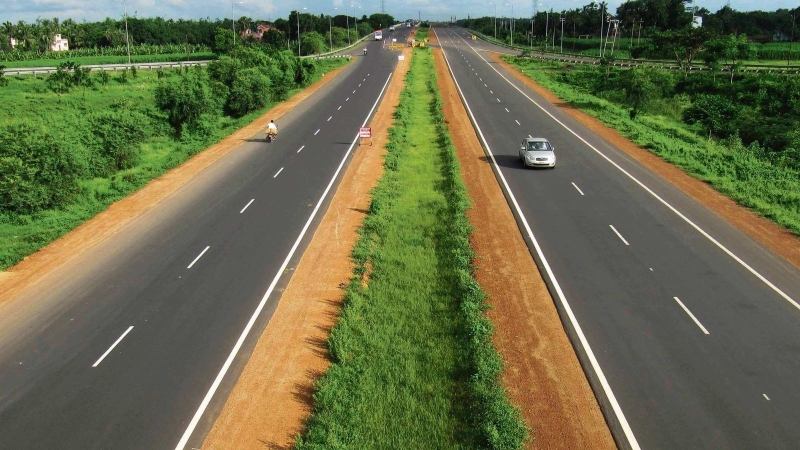- Intimidation or bloodshed cannot halt Bangladesh’s march to democracy |
- Khaleda Zia integral to an important chapter in BD history: Yunus |
- Enthusiasm marks Victory Day celebrations across Bangladesh |
- Dhaka-Delhi ties deep; to be shaped by trust, dignity, mutual respect |
- EU deploys election observation mission to Bangladesh |
Dhaka-Ctg highway 10-lane expansion shelved; focus shifts to railway

Dhaka-Chattogram Highway
Dhaka, Oct 11 - The government has decided to abandon plans to expand the Dhaka–Chattogram highway to a 10-lane road, instead focusing on upgrading the country’s railway network.
The decision comes in response to growing land constraints and the need for a sustainable transport system, said Sheikh Moinuddin, Chief Adviser on matters relating to the Ministry of Road Transport and Bridges and the Ministry of Railways, in an interview with UNB.
“There has been extensive discussion about expanding the Dhaka–Chattogram Highway to six or 10 lanes. However, no final decision has been taken yet. The maximum expansion may be up to six lanes. Beyond that, it is more important to focus on rail travel rather than further road widening,” he said.
Moinuddin emphasised that trains are a fast, safe, and punctual mode of transport, and improving the railway system could shift many people away from driving. “That is why we are emphasising the modernisation of the rail line. At present, plans are underway to renovate and upgrade the Dhaka–Chattogram railway.”
He also pointed out that road expansion would consume more land, a critical concern given Bangladesh’s existing land scarcity.
“Currently, only 2 per cent of goods are transported by rail, which is equivalent to around 2 per cent of GDP. My focus is on railway development to ease pressure on roads, as rail is safe, cost-effective, and environmentally friendly,” Moinuddin said.
Comparing it with international standards, he added, “In many countries, 25 to 30 per cent of goods are transported by rail, whereas in Bangladesh the figure is just 2 per cent. We aim to raise this share to at least 25 per cent. This will make rail freight profitable and reduce congestion on the roads.”
Moinuddin also highlighted a shortage of locomotives as a major issue. “We have already invited tenders for new locomotives. This will increase both speed and efficiency without the need to lay new lines.”
Plans are also in place to dedicate certain trains exclusively for freight, ensuring direct transport to Chattogram Port. “This will cut both time and costs,” he added.
If implemented, these initiatives are expected to reduce road congestion and inject new momentum into Bangladesh’s rail transport system.
The Dhaka–Chattogram Highway is Bangladesh's main artery, connecting the capital with the port city of Chattogram and ending in Teknaf. Yet the highway is often plagued by severe traffic jams due to poor traffic management and road conditions, and a 10-lane expansion had been planned to alleviate congestion and improve safety.
Daily traffic on the highway rose from 35,482 vehicles in 2019 to 46,501 in 2024, according to Roads and Highways Department (RHD) data. Another official from the Highway Police said overloaded vehicles also cause serious damage to roads, forcing the government to spend over Tk 861 crore annually on repairs.
Congestion-Prone Points
The highway’s congestion hotspots include Daudkandi Toll Plaza, Gouripur Bazar, Chandina Bus Stand, Madhaiya Bazar, Nimsar Bazar, the Cantonment area, Alekharchar (Bishwa Road U-turn), Suagazi Bazar, Mia Bazar, and Chauddagram Bazar in Cumilla district. In Feni, Lalpol, Bhatiari Point, Faujdarhat U-turn, Barbakunda Bazar, Chhota Kumira, KDS intersection, and Sitakunda bus stand are also notorious for traffic jams.
Padua Bazar Problem
Padua Bazar, where the Dhaka–Chattogram and Cumilla–Noakhali highways intersect, serves as a critical bypass for traffic moving through six southeastern districts. However, with construction of the planned loop stalled, vehicles rely on risky crossings, as the U-turn needed to access connecting routes remains incomplete.
UNB’s Cumilla correspondent reported that a 105-kilometre stretch from Chauddagram to Daudkandi is in an alarming state, with key sections in Chauddagram upazila, including Noapara, caving in. Experts warn that, as some 80% of Bangladesh’s international trade flows through this route, authorities must prioritise the Dhaka–Chattogram Highway without further delay. - UNB

